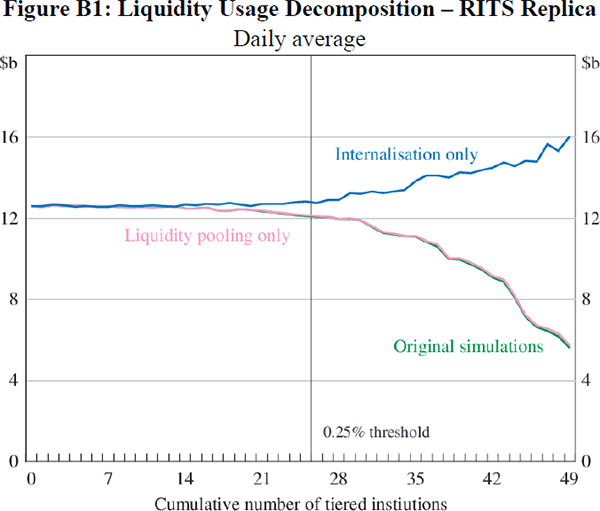RDP 2012-06: The Impact of Payment System Design on Tiering Incentives Appendix B: Decomposing Liquidity Savings
October 2012 – ISSN 1320-7229 (Print), ISSN 1448-5109 (Online)
- Download the Paper 862KB
To decompose liquidity savings into the two sources identified in the literature, namely liquidity pooling and payments internalisation, we follow Lasaosa and Tudela (2008) and run two additional sets of simulations. For this exercise, we examine the cumulative tiering scenarios.
To isolate the impact of liquidity pooling, we run the tiered simulations including the internalised payments that were previously omitted. This involves transforming payments to and from the client into payments to and from the settlement bank, but continuing to settle payments between the settlement bank and its clients in the RTGS system. Since these internalised payments are still being sent through the system, all the liquidity savings from tiering can be attributed to liquidity pooling.
Conversely, to measure liquidity saved due to payments internalisation we omit payments between the client and the settlement bank but otherwise leave the client as a direct participant. Any reduction in liquidity usage in this case will be due to transactions between the client and the settlement bank being settled outside the RTGS system. Note that as multiple clients enter the same tiering network, all payments between them must also be omitted. For example, consider initially that participant B acts as settlement bank for participant A. To measure the internalisation effect when participant B also settles for participant C, payments among participants C, B and A must all be omitted.
Since liquidity pooling and payments internalisation are the only sources of liquidity savings, comparing liquidity savings in the original simulations with those in the additional simulations result in two sets of estimates for the relative importance of the sources of the liquidity savings. Note that these values should be thought of as alternative estimates, not as the upper and lower bound on a range.
There are two reasons for differences in the two sets of estimates for the relative contribution of liquidity pooling and payments internalisation to liquidity savings. First, the complexities of the liquidity recycling process mean that a small change in transaction data can have a substantial effect on the settlement and liquidity profiles. Second, our additional simulations do not perfectly separate out the liquidity-saving effects of tiering. Because the client still participates in the system in the internalisation simulations, the fact that it no longer receives funds from – or pays funds to – the settlement bank creates an artificial and ambiguous effect on its liquidity needs. Note that this effect on liquidity does not exist in the original tiering simulations because in that case the client is completely removed from the system. Hence, this effect could cause the liquidity savings yielded by the internalisation simulations to be materially over- or under-stated.
Figure B1 shows daily average liquidity used in the RITS replica system for different levels of tiering in the original and additional simulations.[20] Note that the green line in this figure is the same as the green RITS replica line in Figure 1. Comparing liquidity use in the original simulations to that in the liquidity-pooling-only simulations suggests that almost all of the liquidity savings from tiering are due to liquidity pooling. In contrast, comparing liquidity use in the original simulations to that in the internalisation-only simulations suggests that the internalisation effect actually increases liquidity needs. However, as discussed above, the simulations designed to capture internalisation effects involve an artificial effect that appears to be putting upward pressure on liquidity needs and thus under-stating the liquidity-saving effect of internalisation.

Footnote
Liquidity savings in the other three system designs exhibit a similar pattern. [20]